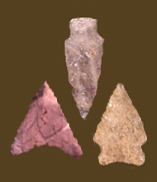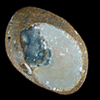WHAT ARE POINTS MADE FROM?
Stone projectile points must be made from suitable materials, and Native Americans knew where to find rocks of the proper size, shape, and quality. In Maryland, the best stone for points is high in silica (like glass) and flakes in a conchoidal (shell-shaped) fracture pattern that produces a sharp cutting edge. Silica-rich materials include chert, chalcedony, jasper, quartz, quartzite, rhyolite, and silicified stones.
More information about some of the rock types in the Photo Galleries can be found on the Virginia Department of Historic Resources website: http://www.dhr.virginia.gov/
arch_DHR/LPCFlash.html.
Click on stone names below to see Photo Galleries.

|
Chalcedony: closely related to chert, chalcedony has a waxy luster and a fibrous structure. Unlike most chert, it is semitransparent or translucent (Luedtke 1992). Chalcedony can assume a wide range of colors, but the most common are white to gray, grayish-blue, or nearly black. It is usually not a common material on Maryland archaeological sites. |
|
Chert: a fine-grained rock, often called “flint.” The terms “microcrystalline” or “cryptocrystalline” are used to describe the size of the silica grains in chert, which are not visible to the eye (Luedtke 1992). It ranges greatly in color. Gray, black, and white variations are common, but it can also be shades of green, red, brown, or other colors. Heat treating chert often results in stone that is waxier, darker, and/or redder in appearance. Chert occurs in thin beds or as irregular nodules in sedimentary carbonate formations such as limestone. Shriver chert in western Maryland is an example of bedded chert. Chert cobbles that have washed out from their parent formations can be found along waterways throughout Maryland. Because flowing water can move small rocks farther than big ones, the largest cobbles generally are found closer to river headwaters. |
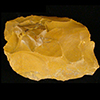
|
Jasper: a variety of chert colored in shades of red, yellow, orange, or brown due to the presence of iron impurities (Ebright n.d.). It often has a lustrous and waxy appearance. Heat treating jasper generally causes it to look waxier and redder. Point of Rocks in Frederick County was a well-known jasper outcrop, and other major sources are located in Berks County, PA, Warren and Culpepper counties, VA., and in Cecil County, MD and New Castle County, DE, in the area around Newark (Iron Hill). Jasper is also found in cobble/pebble form in gravel deposits on the coastal plain of Maryland. When buried in tidal marshes, the surface color and appearance of iron-rich stones such as jasper often change. Under these conditions, jasper can be indistinguishable from other chert (Lowery and Wagner 2012). |

|
Quartz: associated with igneous and metamorphic rocks, it is the most abundant mineral on earth. Most archaeological quartz in Maryland is microcrystalline, meaning the individual silica grains are too small to see with the eye. It is known as “massive quartz” (Ebright n.d.). Highly variable in quality, it outcrops in the Maryland Blue Ridge and Piedmont, often highly fractured and breaking into blocky segments. Samples from the same vein can vary in color from clear to cloudy to milky white, as well as rose, blue, and smoky. Some archaeological quartz is the macrocrystalline six-sided version known as “quartz crystal.” Quartz is commonly found as small cobbles in streams, except in far Western Maryland, where quartz artifacts are rare (Wall 1992). |

|
Quartzite: a hard rock, originally composed of sandstone, that fractures through individual silica grains rather than around them. Quartzite can be created by the tight cementation and compaction of the sandstone grains in sedimentary contexts (orthoquartzite), or through the metamorphoric distortion of the sandstone. The quality of quartzite is variable, from a sugary texture to smooth and glassy, but highly metamorphized quartzite can flake as easily as chert. Quartzite usually occurs in shades of gray, white, red, and brown, and can contain inclusions such as small, dark lignite particles (Lowery 2002). Massive beds of quartzite are found on the western slopes of the Maryland Blue Ridge, and smaller outcrops occur on the west side of the Chesapeake. It commonly occurs as cobbles along streams. Orthoquartzites from sources around the Chesapeake come in a wide variety of colors, but tend to be darker when freshly exposed, and often become lighter as they weather (Lowery 2002). |
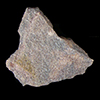
|
Rhyolite: an extrusive volcanic rock. It is a microscopically fine-grained (aphanitic) material, although many rhyolites are also porphyritic, meaning scattered visible crystals known as phenocrysts are embedded in the stone (Andrefsky 1998). The material called “rhyolite” in the eastern U.S. is technically metarhyolite, a slightly metamorphosed form of rhyolite. A number of varieties outcrop in Maryland’s Frederick and Washington counties. They are most commonly dark blue-gray to black, but other colors occur as well, and weathering can result in lighter hues. Visually-distinct varieties include: 1) aphanitic; 2) porphyritic; 3) red; 4) banded; 5) mottled (Stewart 1984). Varieties 3, 4, and 5 occur both with and without phenocrysts. A greenish metarhyolite, probably from a nearby source, was found in large quantities at the Jefferson Site in Frederick County. Adams County, PA produces a mottled metarhyolite sometimes used for artifacts found in Maryland. Large outcroppings of metarhyolites also are found near Mount Rogers, VA and the Uwharrie Mountains (Morrow Mountain) of North Carolina, and other local and regional types exist. The term “Carolina Slate” is sometimes used for various similar fine-grained stones, including metarhyolite, found in the Carolina Slate Belt that runs from Virginia to Georgia (Coe 1995). Some very fine-grained metarhyolites have a chert-like appearance (Ebright n.d.). |

|
Silicified Stone: occurs when silica is introduced into a rock via groundwater or fluids of volcanic origin. The introduced silica either fills spaces in the rock or replaces preexisting minerals. Petrified wood is a silicified material, and was occasionally used for tools on the Eastern Shore (Lowery 2002). Silicified sandstone is found at various locations in Maryland, especially on the Coastal Plain. It can be difficult to distinguish this material from quartzite with the naked eye (Andrefsky 1998), but the individual grain boundaries in silicified sandstone are distinct from the surrounding cement. On the Eastern Shore, it often has a gray/blue translucent appearance when freshly exposed, with inclusions of microfossils and dark lignite particles (Lowery 2002). It weathers severely, and can fall apart with age. Indians utilized silicified sandstone from along the Choptank and Wye rivers on the Eastern Shore, as well as on the Potomac River in Southern Maryland. Silicified sandstone was used during the Late Archaic period in far Western Maryland (Wall 1992). A finer-grained material, silicified siltstone, was also used in that region (Ebright n.d.), and silicified mudstone tools have been found on the Eastern Shore. High quality silicified mudstone is fine grained and fractures conchoidally (Lowery 2002). |
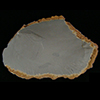
|
Other Types: Argillite is a homogenous dark material that is metamorphosed from fine-grained stone like siltstone, mudstone, or shale. It is commonly purple or black to gray, with gradations of color possible in a single stone. Phenocrysts are sometimes present. It weathers easily, which can change its color and create a porous or bumpy surface. Argillite can be virtually indistinguishable from hornfels, which is produced from more-highly metamorphosed clay-rich stones (Andrefsky 1998).
Ferruginous sandstone, sometimes called ironstone, is formed when limonite -- an iron oxide precipitate – cements sandstone grains together. It typically occurs in “rusty” shades of red and brown. High-quality ferruginous sandstone can be flaked like quartzite, and fluted points made from it have been found on the Eastern Shore (Ebright n.d.; Lowery 2002). |
|

![]()


